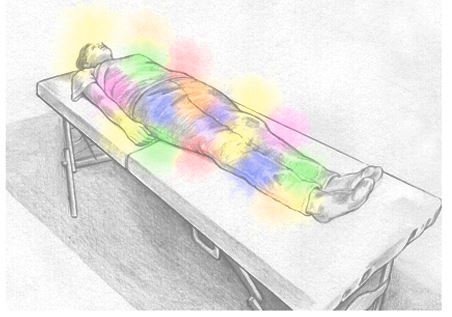
- What is massage?
- Massage is a "hands on" treatment in which a therapist manipulates muscles and other soft tissues of the body to improve health and well being. Varieties of massage range from gentle stroking and kneading of muscles and other soft tissues to deeper manual techniques. Massage has been practiced as a healing therapy for centuries in nearly every culture around the world. It helps relieve muscle tension, reduce stress, and evoke feelings of calmness. Although massage affects the body as a whole, it particularly influences the activity of the musculoskeletal, circulatory, lymphatic, and nervous systems.
- What is the history of massage?
3000 BC- Chinese: Cong-Fu of the Toa-Tse. Oldest known book written about massage. Translated to French in 1700’s.
- W.W.I- Swedish massage used for rehabilitation of injured soldiers.
- source http://thebodyworker.com/history.htm
The most common types Healing in Motion practice include:
- Swedish massage: A variety of strokes and pressure techniques are used to enhance the flow of blood to the heart, remove waste products from the tissues, stretch ligaments and tendons, and ease physical and emotional tension.
- Remedial massage combined with Remedial exercises to improve range of movement and function, using deep tissue massage techniques.
- Trigger point massage: Pressure is applied to "trigger points" (tender areas where the muscles have been damaged) to alleviate muscle spasms and pain.
Compassionate touch: Combines one on one focused attention, intentional touch, and sensitive massage with communication to enhance the quality of life for elderly, ill, or dying patients.
Pre/post, Sports massage: Often used on professional athletes and other active individuals, sports massage can enhance performance and prevent and treat sports related injuries
Indian Champissage (Head Massage) - Massage has always played an important part in Indian life. It features in the earliest Ayurvedic texts, which date back nearly 4000 years. These ancient texts describe that, when used in conjunction with herbs, spices and aromatic oils, massage had an important medical function and could not only “strengthen muscles and firm skin”, but also encourage the body’s innate healing energy.
Indian Head Massage (Champissage™) includes massage of the shoulders, upper arms, neck, scalp, face, ears and energy balancing. This method is the brainchild of Narendra Mehta. It is based on the traditional form of Champi (head massage) practised in India for over 1,000 years. It is a wonderfully relaxing therapy. The massage is safe, simple to learn and very effective to give, without the need to undress or use oils. It can provide relief from aches and pains, stress symptoms, insomnia, promote hair growth, soothe, comfort and rebalance your energy flow which gives you a deep sense of peace, calm and tranquillity. Hot oil hair treatment during IHM can be added as an additional therapy.
Baby/infant massage as an instructor as well as a practitioner I use demonstration doll to show how to massage baby.
- Baby massage can be relaxing for mum and baby. Yes, babies get stressed too being in new environments and they also pick up on your stress. Taking time out together for a massage teaches baby how to relax, and you will relax too.
- Massage has lots of physical benefits and for babies can play a vital role in circulation, digestion and growth. Using simple techniques you can ease the symptoms of colds, colic and teething. Massage can help babies who are premature and those with disabilities too, improving muscle tone and stimulating growth hormones.
- Baby massage and bonding
- Bonding with your baby can take time and doesn't always happen easily. The bonding experience can be encouraged through touch, through spending quality time together and through eye-to-eye contact with you baby. Baby massage can play a vital role in this process particulalrly if you've struggled due to postnatal depression, an early baby or medical problems. It's a great thing for dad to learn too, especially if mum is breast feeding and he feels left out.
Please do not stop any treatments your medical practitioner may have given complementary therapies are not designed as substitutes for medical care.